
Illustrative Math Alignment: Grade 8 Unit 9
Putting It All Together
Lesson 3: Tessellating Polygons
Use the following Media4Math resources with this Illustrative Math lesson.
| Thumbnail Image | Title | Body | Curriculum Topic |
|---|---|---|---|
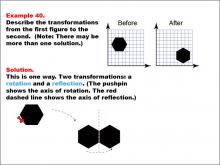
|
Math Example--Geometric Transformation--Transformations: Example 40 | Math Example--Geometric Transformation--Transformations: Example 40TopicTransformations DescriptionThis example illustrates a combination of rotation and reflection in geometric transformations. The image shows a hexagon on a grid, with a "Before" and "After" transformation. A pushpin indicates the axis of rotation, and a red dashed line shows the axis of reflection. This demonstrates how multiple transformations can be applied sequentially to create more complex changes in orientation and position. |
Definition of Transformations |

|
Math Example--Geometric Transformation--Transformations: Example 41 | Math Example--Geometric Transformation--Transformations: Example 41TopicTransformations DescriptionThis example demonstrates a single reflection in geometric transformations. The image shows two hexagons on a grid, labeled "Before" and "After." The hexagon is reflected over a vertical axis, with a red dashed line indicating the reflection axis. This illustrates how an object can be flipped over a line while maintaining its size and shape but changing its orientation. |
Definition of Transformations |
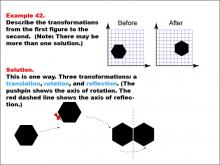
|
Math Example--Geometric Transformation--Transformations: Example 42 | Math Example--Geometric Transformation--Transformations: Example 42TopicTransformations DescriptionThis example demonstrates a complex combination of transformations: translation, rotation, and reflection. The image shows two hexagons on a grid, labeled "Before" and "After." There are three transformations: first, a translation moves the shape, then a rotation turns it (indicated by a pushpin showing the axis of rotation), and finally, a reflection flips it across a red dashed line representing the axis of reflection. |
Definition of Transformations |
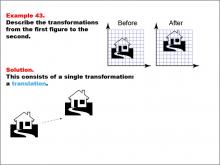
|
Math Example--Geometric Transformation--Transformations: Example 43 | Math Example--Geometric Transformation--Transformations: Example 43TopicTransformations DescriptionThis example demonstrates a simple translation in geometric transformations. The image shows two house icons on a grid, labeled "Before" and "After." The house is translated horizontally to the right, with an arrow indicating the movement direction. This showcases how an object can move position without changing its size or orientation. |
Definition of Transformations |
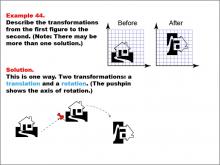
|
Math Example--Geometric Transformation--Transformations: Example 44 | Math Example--Geometric Transformation--Transformations: Example 44TopicTransformations DescriptionThis example illustrates a combination of translation and rotation in geometric transformations. The image shows two house icons on a grid, labeled "Before" and "After." Two transformations occur: translation (shown by an arrow) and rotation (shown by a pushpin). This demonstrates how multiple transformations can be applied sequentially to create more complex changes in position and orientation. |
Definition of Transformations |
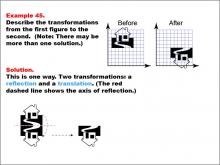
|
Math Example--Geometric Transformation--Transformations: Example 45 | Math Example--Geometric Transformation--Transformations: Example 45TopicTransformations DescriptionThis example demonstrates a combination of reflection and translation in geometric transformations. The image shows two figures labeled as "Before" and "After." The left figure illustrates a shape on a grid, while the right figure shows the same shape after a transformation involving reflection and translation, marked with a dashed red line. This illustrates how multiple transformations can be applied sequentially to create more complex changes in position and orientation. |
Definition of Transformations |
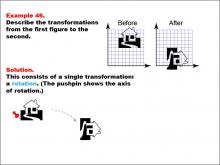
|
Math Example--Geometric Transformation--Transformations: Example 46 | Math Example--Geometric Transformation--Transformations: Example 46TopicTransformations DescriptionThis example demonstrates a single rotation in geometric transformations. The image presents two figures labeled "Before" and "After." The left figure shows a shape on a grid, while the right one displays the same shape after a rotation around a specified point marked with a pushpin. This illustrates how an object can change its orientation without altering its size or shape. |
Definition of Transformations |
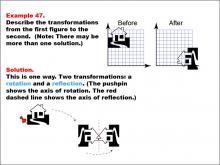
|
Math Example--Geometric Transformation--Transformations: Example 47 | Math Example--Geometric Transformation--Transformations: Example 47TopicTransformations DescriptionThis example illustrates a combination of rotation and reflection in geometric transformations. Two figures are presented, labeled "Before" and "After." The left figure shows the original shape on a grid, while the right figure depicts the shape after undergoing a combination of transformations: first, a rotation around a point indicated by a pushpin, followed by a reflection across a dashed red line. |
Definition of Transformations |
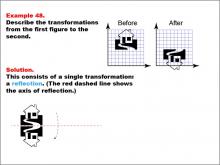
|
Math Example--Geometric Transformation--Transformations: Example 48 | Math Example--Geometric Transformation--Transformations: Example 48TopicTransformations DescriptionThis example demonstrates a single reflection in geometric transformations. The image shows two figures labeled as "Before" and "After." The left figure includes a shape positioned within a grid, and the right figure illustrates the transformed shape after reflecting across a dashed red line. This showcases how an object can be flipped over a line while maintaining its size and shape but changing its orientation. |
Definition of Transformations |
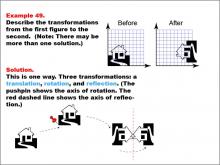
|
Math Example--Geometric Transformation--Transformations: Example 49 | Math Example--Geometric Transformation--Transformations: Example 49TopicTransformations DescriptionThis example demonstrates a complex combination of transformations: translation, rotation, and reflection. The image shows two house-shaped figures on a grid. The "Before" figure is on the left, and the "After" figure is on the right. The transformation involves three steps: first, a translation moves the shape, then a rotation turns it around an axis marked by a pushpin, and finally, a reflection flips it across a dashed red line representing the axis of reflection. |
Definition of Transformations |
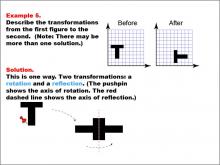
|
Math Example--Geometric Transformation--Transformations: Example 5 | Math Example--Geometric Transformation--Transformations: Example 5TopicTransformations DescriptionThis example illustrates a combination of rotation and reflection in geometric transformations. Two grids labeled "Before" and "After" show a black "T" shape in different orientations. The shape first undergoes a rotation, indicated by a pushpin showing the axis of rotation, and then a reflection, shown by a red dashed line representing the axis of reflection. This demonstrates how multiple transformations can be applied sequentially to create more complex changes in orientation and position. |
Definition of Transformations |
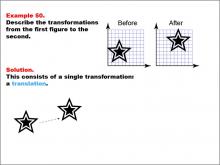
|
Math Example--Geometric Transformation--Transformations: Example 50 | Math Example--Geometric Transformation--Transformations: Example 50TopicTransformations DescriptionThis example demonstrates a simple translation in geometric transformations. The image shows two star-shaped figures on a grid. The "Before" figure is on the left, and the "After" figure is on the right. The transformation consists of a simple translation from left to right, showcasing how an object can move position without changing its size or orientation. |
Definition of Transformations |
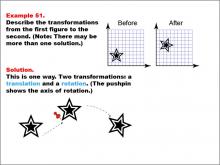
|
Math Example--Geometric Transformation--Transformations: Example 51 | Math Example--Geometric Transformation--Transformations: Example 51TopicTransformations DescriptionThis example illustrates a combination of translation and rotation in geometric transformations. The image shows two star-shaped figures on a grid. The "Before" figure is on the left, and the "After" figure is on the right. There are two transformations: first, a translation moves the shape, then a rotation turns it around an axis marked by a pushpin. This demonstrates how multiple transformations can be applied sequentially to create more complex changes in position and orientation. |
Definition of Transformations |
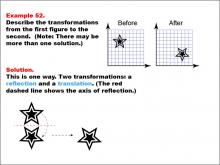
|
Math Example--Geometric Transformation--Transformations: Example 52 | Math Example--Geometric Transformation--Transformations: Example 52TopicTransformations DescriptionThis example demonstrates a combination of reflection and translation in geometric transformations. The image shows two star-shaped figures on a grid. The "Before" figure is on the left, and the "After" figure is on the right, located lower and to the right. There are two transformations: first, a reflection across an axis shown by a red dashed line, followed by a translation to move the shape to its final position. This illustrates how multiple transformations can be applied sequentially to create more complex changes in position and orientation. |
Definition of Transformations |
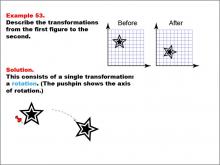
|
Math Example--Geometric Transformation--Transformations: Example 53 | Math Example--Geometric Transformation--Transformations: Example 53TopicTransformations DescriptionThis example demonstrates a single rotation in geometric transformations. The image shows a star on a grid labeled "Before" and "After." The star has been rotated to a new position on the grid, as indicated by a pushpin that marks the axis of rotation. This illustrates how an object can change its orientation without altering its size or shape. |
Definition of Transformations |
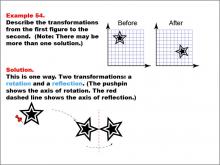
|
Math Example--Geometric Transformation--Transformations: Example 54 | Math Example--Geometric Transformation--Transformations: Example 54TopicTransformations DescriptionThis example illustrates a combination of rotation and reflection in geometric transformations. The image displays a star on a grid with "Before" and "After" labels. The transformation involves two steps: first, a rotation around an axis marked by a pushpin, and second, a reflection across a vertical axis shown by a red dashed line. This demonstrates how multiple transformations can be applied sequentially to create more complex changes in orientation and position. |
Definition of Transformations |
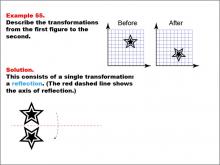
|
Math Example--Geometric Transformation--Transformations: Example 55 | Math Example--Geometric Transformation--Transformations: Example 55TopicTransformations DescriptionThis example demonstrates a single reflection in geometric transformations. In this image, a star is shown before and after undergoing a reflection. The red dashed line represents the axis of reflection, which is horizontal in this case. This showcases how an object can be flipped over a line while maintaining its size and shape but changing its orientation. |
Definition of Transformations |
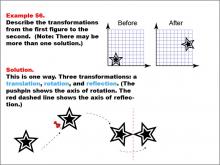
|
Math Example--Geometric Transformation--Transformations: Example 56 | Math Example--Geometric Transformation--Transformations: Example 56TopicTransformations DescriptionThis example demonstrates a complex combination of transformations: translation, rotation, and reflection. The image shows three transformations applied to the star: first, a translation moves the star to another position, then a rotation turns it around an axis indicated by a pushpin, and finally a reflection flips it across a vertical axis shown by a red dashed line. This illustrates how multiple transformations can be applied sequentially to create more complex changes in position and orientation. |
Definition of Transformations |
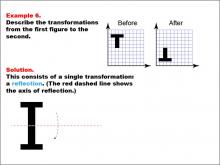
|
Math Example--Geometric Transformation--Transformations: Example 6 | Math Example--Geometric Transformation--Transformations: Example 6TopicTransformations DescriptionThis example demonstrates a single reflection in geometric transformations. Two grids labeled "Before" and "After" show a black "T" shape in different orientations. The solution diagram below illustrates a reflection of the shape across a red dashed line, which represents the axis of reflection. This transformation showcases how an object can be flipped over a line while maintaining its size and shape. |
Definition of Transformations |

|
Math Example--Geometric Transformation--Transformations: Example 7 | Math Example--Geometric Transformation--Transformations: Example 7TopicTransformations DescriptionThis example illustrates a complex combination of transformations: translation, rotation, and reflection. Two grids labeled "Before" and "After" show a black "T" shape in different orientations. The solution diagram below demonstrates three sequential transformations: first, a translation moves the shape, then a rotation turns it (indicated by a pushpin showing the axis of rotation), and finally, a reflection flips it across a red dashed line representing the axis of reflection. |
Definition of Transformations |
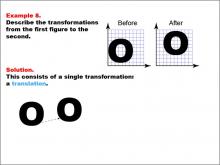
|
Math Example--Geometric Transformation--Transformations: Example 8 | Math Example--Geometric Transformation--Transformations: Example 8TopicTransformations DescriptionThis example demonstrates a simple translation in geometric transformations. Two grids labeled "Before" and "After" show an "O" shape slightly shifted between the grids. The solution diagram below illustrates a translation of the shape from one position to another, showcasing how an object can move position without changing its size or orientation. |
Definition of Transformations |
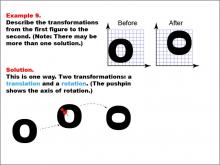
|
Math Example--Geometric Transformation--Transformations: Example 9 | Math Example--Geometric Transformation--Transformations: Example 9TopicTransformations DescriptionThis example illustrates a combination of transformations: translation and rotation. Two circular "O" shapes are shown on a grid, one labeled "Before" and the other "After". The solution involves a translation (movement) and a rotation, with a pushpin indicating the axis of rotation. This demonstrates how multiple transformations can be applied sequentially to a shape. |
Definition of Transformations |
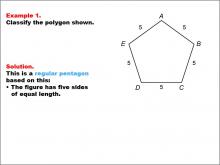
|
Math Example--Polygons--Polygon Classification: Example 1 | Math Example--Polygons--Polygon Classification: Example 1TopicPolygons DescriptionThis example showcases a pentagon with all sides labeled as 5. It demonstrates a regular pentagon, characterized by five sides of equal length. This visual representation helps students understand the concept of regular polygons and their defining characteristics. The topic of polygon classification is crucial in geometry. This collection of examples provides a comprehensive look at various types of pentagons, both regular and irregular. By examining different configurations of sides and angles, students can develop a deeper understanding of polygon properties and classification criteria. |
Definition of a Polygon |
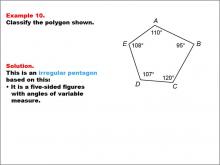
|
Math Example--Polygons--Polygon Classification: Example 10 | Math Example--Polygons--Polygon Classification: Example 10TopicPolygons DescriptionThis example showcases a pentagon labeled with vertices A, B, C, D, E, where the angles are marked as 110°, 95°, 120°, 107°, and 108°. It demonstrates an irregular pentagon based on the variation in angle measures, highlighting that regularity depends on both side lengths and angle measures. Understanding polygon classification is essential in geometry as it helps students recognize and categorize shapes based on their properties. This collection of examples emphasizes the importance of both side lengths and angle measures in determining the regularity of pentagons. |
Definition of a Polygon |
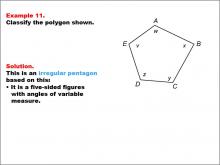
|
Math Example--Polygons--Polygon Classification: Example 11 | Math Example--Polygons--Polygon Classification: Example 11TopicPolygons DescriptionThis example presents a pentagon labeled with vertices A, B, C, D, E, where the sides are marked with variables w, x, y, z, and v. It illustrates an irregular pentagon by using different variables to represent potentially different side lengths, emphasizing that side length variation results in irregularity. Polygon classification is a fundamental concept in geometry that helps students analyze and categorize shapes based on their properties. This collection of examples provides a comprehensive look at various types of pentagons, highlighting the importance of side length equality in determining regularity. |
Definition of a Polygon |
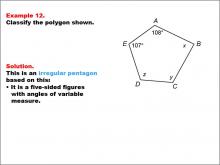
|
Math Example--Polygons--Polygon Classification: Example 12 | Math Example--Polygons--Polygon Classification: Example 12TopicPolygons DescriptionThis example features a pentagon labeled with vertices A, B, C, D, E, where the angles are marked as 108°, x, y, z, and 107°. It demonstrates an irregular pentagon based on the variation in angle measures, highlighting that regularity depends on all angles being equal. Understanding polygon classification is essential in geometry as it helps students recognize and categorize shapes based on their properties. This collection of examples emphasizes the importance of angle measures in determining the regularity of pentagons, showing that even one different angle makes the polygon irregular. |
Definition of a Polygon |
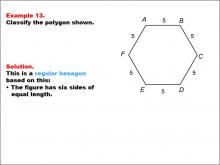
|
Math Example--Polygons--Polygon Classification: Example 13 | Math Example--Polygons--Polygon Classification: Example 13TopicPolygons DescriptionThis example showcases a hexagon with all sides labeled as 5, indicating equal length. It demonstrates a regular hexagon, characterized by six sides of equal length. This visual representation helps students understand the concept of regular polygons and their defining characteristics. The topic of polygon classification is crucial in geometry. This collection of examples provides a comprehensive look at various types of hexagons, both regular and irregular. By examining different configurations of sides and angles, students can develop a deeper understanding of polygon properties and classification criteria. |
Definition of a Polygon |
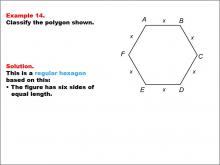
|
Math Example--Polygons--Polygon Classification: Example 14 | Math Example--Polygons--Polygon Classification: Example 14TopicPolygons DescriptionThis example presents a hexagon with all sides labeled as x, indicating equal length. It illustrates another instance of a regular hexagon, reinforcing the concept that a regular polygon has all sides of equal length, even when represented by a variable. Polygon classification is a fundamental topic in geometry that helps students understand the properties and characteristics of different shapes. This collection of examples provides a comprehensive overview of various hexagon types, allowing students to distinguish between regular and irregular polygons based on their side lengths and angle measures. |
Definition of a Polygon |
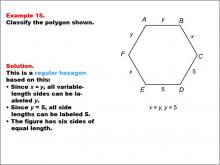
|
Math Example--Polygons--Polygon Classification: Example 15 | Math Example--Polygons--Polygon Classification: Example 15TopicPolygons DescriptionThis example features a hexagon with sides labeled y, x, and 5, showing that x = y = 5, making all sides equal in length. It demonstrates a regular hexagon by using a combination of variables and numeric values to represent equal side lengths. Understanding polygon classification is crucial in geometry as it helps students recognize and categorize shapes based on their properties. This collection of examples highlights different ways to represent regular hexagons, emphasizing the importance of side length equality in classification. |
Definition of a Polygon |
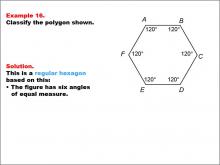
|
Math Example--Polygons--Polygon Classification: Example 16 | Math Example--Polygons--Polygon Classification: Example 16TopicPolygons DescriptionThis example showcases a hexagon with all interior angles labeled as 120 degrees, indicating equal angles. It demonstrates that a regular hexagon can be identified not only by equal side lengths but also by equal angle measures, reinforcing the dual criteria for regularity in polygons. Polygon classification is a fundamental concept in geometry that helps students analyze and categorize shapes based on their properties. This collection of examples provides a comprehensive look at various aspects of regular hexagons, emphasizing both side length and angle measure as defining characteristics. |
Definition of a Polygon |
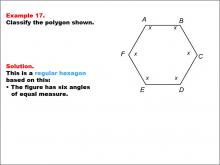
|
Math Example--Polygons--Polygon Classification: Example 17 | Math Example--Polygons--Polygon Classification: Example 17TopicPolygons DescriptionThis example presents a hexagon with six equal sides labeled as x and equal angles, indicating a regular hexagon. It reinforces the concept of a regular polygon by visually representing both the equality of all sides and angles. Understanding polygon classification is essential in geometry as it helps students recognize and categorize shapes based on their properties. This collection of examples provides various representations of regular hexagons, emphasizing the importance of both side length and angle measure equality in classification. |
Definition of a Polygon |
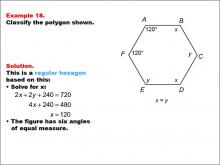
|
Math Example--Polygons--Polygon Classification: Example 18 | Math Example--Polygons--Polygon Classification: Example 18TopicPolygons DescriptionThis example features a hexagon with two angles labeled as 120 degrees and sides labeled x and y, where x = y. It demonstrates how to determine if a hexagon is regular by solving for the unknown angle measures and confirming equal side lengths. Polygon classification is a crucial topic in geometry that helps students distinguish between regular and irregular shapes. This collection of examples provides a comprehensive look at various types of hexagons, highlighting the importance of both angle measures and side lengths in determining regularity. |
Definition of a Polygon |

|
Math Example--Polygons--Polygon Classification: Example 19 | Math Example--Polygons--Polygon Classification: Example 19TopicPolygons DescriptionThis example showcases a hexagon with sides labeled with varying lengths: AB = 6, BC = 4, CD = 6, DE = 3, EF = 6, and FA = 5. It demonstrates an irregular hexagon, emphasizing that side length variation results in irregularity. Understanding polygon classification is crucial in geometry as it helps students recognize and categorize shapes based on their properties. This collection of examples highlights the differences between regular and irregular hexagons, focusing on side length as a key determining factor. |
Definition of a Polygon |
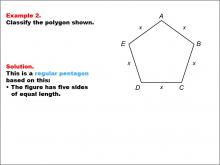
|
Math Example--Polygons--Polygon Classification: Example 2 | Math Example--Polygons--Polygon Classification: Example 2TopicPolygons DescriptionThis example presents a pentagon with all sides labeled as x, indicating equal length. It illustrates another instance of a regular pentagon, reinforcing the concept that a regular polygon has all sides of equal length. Polygon classification is a fundamental topic in geometry that helps students understand the properties and characteristics of different shapes. This collection of examples provides a comprehensive overview of various pentagon types, allowing students to distinguish between regular and irregular polygons based on their side lengths and angle measures. |
Definition of a Polygon |
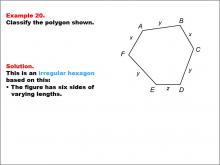
|
Math Example--Polygons--Polygon Classification: Example 20 | Math Example--Polygons--Polygon Classification: Example 20TopicPolygons DescriptionThis example presents a hexagon with sides labeled as x, y, and z, indicating varying lengths. It illustrates another case of an irregular hexagon, demonstrating that the presence of different variables for side lengths suggests irregularity. Polygon classification is a fundamental concept in geometry that helps students analyze and categorize shapes based on their properties. This collection of examples provides a comprehensive look at various types of hexagons, emphasizing the importance of side length equality in determining regularity. |
Definition of a Polygon |
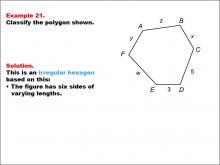
|
Math Example--Polygons--Polygon Classification: Example 21 | Math Example--Polygons--Polygon Classification: Example 21
This is part of a collection of math examples that focus on geometric shapes. |
Definition of a Polygon |

|
Math Example--Polygons--Polygon Classification: Example 22 | Math Example--Polygons--Polygon Classification: Example 22
This is part of a collection of math examples that focus on geometric shapes. |
Definition of a Polygon |

|
Math Example--Polygons--Polygon Classification: Example 23 | Math Example--Polygons--Polygon Classification: Example 23
This is part of a collection of math examples that focus on geometric shapes. |
Definition of a Polygon |
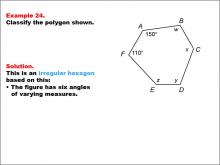
|
Math Example--Polygons--Polygon Classification: Example 24 | Math Example--Polygons--Polygon Classification: Example 24
This is part of a collection of math examples that focus on geometric shapes. |
Definition of a Polygon |
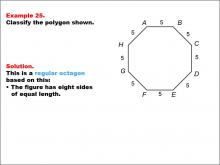
|
Math Example--Polygons--Polygon Classification: Example 25 | Math Example--Polygons--Polygon Classification: Example 25TopicPolygons DescriptionThis example showcases an octagon with all sides labeled as 5, indicating equal length. It demonstrates a regular octagon, characterized by eight sides of equal length. This visual representation helps students understand the concept of regular polygons and their defining characteristics. The topic of polygon classification is crucial in geometry. This collection of examples provides a comprehensive look at various types of octagons, both regular and irregular. By examining different configurations of sides and angles, students can develop a deeper understanding of polygon properties and classification criteria. |
Definition of a Polygon |
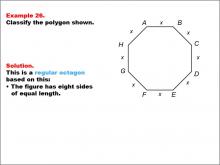
|
Math Example--Polygons--Polygon Classification: Example 26 | Math Example--Polygons--Polygon Classification: Example 26TopicPolygons DescriptionThis example presents an octagon with all sides labeled as x, indicating equal length. It illustrates another instance of a regular octagon, reinforcing the concept that a regular polygon has all sides of equal length, even when represented by a variable. Understanding polygon classification is essential in geometry as it helps students recognize and categorize shapes based on their properties. This collection of examples provides various representations of regular octagons, emphasizing the importance of side length equality in classification. |
Definition of a Polygon |

|
Math Example--Polygons--Polygon Classification: Example 27 | Math Example--Polygons--Polygon Classification: Example 27TopicPolygons DescriptionThis example features an octagon with sides labeled as x, z, and 5, showing that x = z = 5, indicating equal length for all sides. It demonstrates a regular octagon by using a combination of variables and numeric values to represent equal side lengths. Polygon classification is a fundamental concept in geometry that helps students analyze and categorize shapes based on their properties. This collection of examples provides a comprehensive look at various aspects of regular octagons, emphasizing the importance of side length equality in classification. |
Definition of a Polygon |
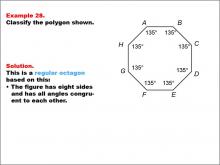
|
Math Example--Polygons--Polygon Classification: Example 28 | Math Example--Polygons--Polygon Classification: Example 28TopicPolygons DescriptionThis example showcases an octagon with all angles labeled as 135 degrees, indicating congruent angles. It demonstrates that a regular octagon can be identified not only by equal side lengths but also by equal angle measures, reinforcing the dual criteria for regularity in polygons. Understanding polygon classification is crucial in geometry as it helps students recognize and categorize shapes based on their properties. This collection of examples highlights different aspects of regular octagons, emphasizing both side length and angle measure as defining characteristics. |
Definition of a Polygon |
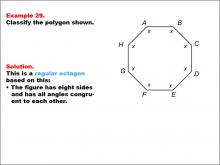
|
Math Example--Polygons--Polygon Classification: Example 29 | Math Example--Polygons--Polygon Classification: Example 29TopicPolygons DescriptionThis example presents an octagon with all angles labeled as "x," indicating a regular polygon. It illustrates a regular octagon by visually representing the equality of all angles using a single variable. This reinforces the concept that a regular polygon has all angles of equal measure. Polygon classification is a fundamental concept in geometry that helps students analyze and categorize shapes based on their properties. This collection of examples provides a comprehensive look at various aspects of regular octagons, emphasizing the importance of side length equality in classification. |
Definition of a Polygon |
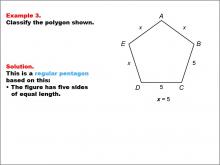
|
Math Example--Polygons--Polygon Classification: Example 3 | Math Example--Polygons--Polygon Classification: Example 3TopicPolygons DescriptionThis example features a pentagon with sides labeled x and two sides labeled as 5, with x = 5, demonstrating that all sides are equal. It reinforces the concept of a regular pentagon by showing how different notations can represent the same length. The study of polygon classification helps students develop critical thinking skills in geometry. This collection of examples illustrates various ways to represent and identify regular pentagons, emphasizing the importance of side length equality in classification. |
Definition of a Polygon |

|
Math Example--Polygons--Polygon Classification: Example 30 | Math Example--Polygons--Polygon Classification: Example 30TopicPolygons DescriptionThis example features an octagon with angles labeled as 135° and angles labeled as "u" and "x." It demonstrates how to determine if an octagon is regular by solving for the unknown angle measures and confirming equal side lengths. Understanding polygon classification is essential in geometry as it helps students recognize and categorize shapes based on their properties. This collection of examples provides insights into how partial information about angle measures and side lengths can be used to determine the regularity of octagons. |
Definition of a Polygon |
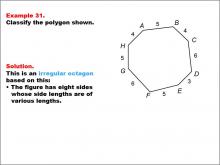
|
Math Example--Polygons--Polygon Classification: Example 31 | Math Example--Polygons--Polygon Classification: Example 31TopicPolygons DescriptionThis example showcases an irregular octagon with sides of varying lengths labeled as 4, 5, 6, and 3. It demonstrates that not all eight-sided figures are regular, emphasizing the importance of equal side lengths in the classification of regular polygons. Polygon classification is a crucial topic in geometry that helps students distinguish between regular and irregular shapes. This collection of examples provides a comprehensive look at various types of octagons, highlighting the differences between regular and irregular polygons based on side lengths. |
Definition of a Polygon |

|
Math Example--Polygons--Polygon Classification: Example 32 | Math Example--Polygons--Polygon Classification: Example 32TopicPolygons DescriptionThis example presents an irregular octagon with sides labeled as w, x, y, z, and u, indicating varying lengths. It illustrates another case of an irregular octagon, demonstrating that the presence of different variables for side lengths suggests irregularity. Understanding polygon classification is crucial in geometry as it helps students recognize and categorize shapes based on their properties. This collection of examples highlights the importance of considering side lengths when determining the regularity of octagons. |
Definition of a Polygon |
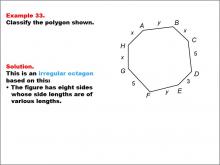
|
Math Example--Polygons--Polygon Classification: Example 33 | Math Example--Polygons--Polygon Classification: Example 33TopicPolygons DescriptionThis example features an octagon with sides labeled as x, y, 5, and 3. The sides are of varying lengths, indicating it is irregular. It demonstrates how a combination of variables and specific numeric values can be used to show irregularity in polygons. Polygon classification is a fundamental concept in geometry that helps students analyze and categorize shapes based on their properties. This collection of examples provides insights into how partial information about side lengths can be used to determine the irregularity of octagons. |
Definition of a Polygon |
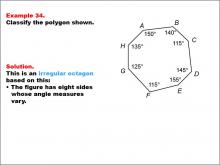
|
Math Example--Polygons--Polygon Classification: Example 34 | Math Example--Polygons--Polygon Classification: Example 34TopicPolygons DescriptionThis example showcases an octagon with angles labeled as 150°, 140°, 115°, 145°, 155°, 115°, 125°, and 135°. The angles vary, indicating it is irregular. It demonstrates that irregularity in polygons can be determined by examining angle measures alone. Understanding polygon classification is essential in geometry as it helps students recognize and categorize shapes based on their properties. This collection of examples highlights the importance of angle measures in determining the regularity of octagons, showing that even if side lengths are not given, angle information can be sufficient for classification. |
Definition of a Polygon |